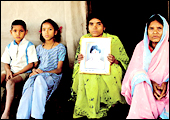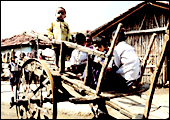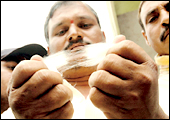|
Lakshmi
Bhindare sits outside her mud hut, clutching a framed photo of
her husband. There's a date scrawled in Marathi across the bottom
of the picture: 19.1.2006. That was the day when Nanda Nameshwar
Bhindare went out to his small 10-acre farm outside this village
of Bhadmuri, 160-km southwest of Nagpur.
It was a trip he had made thousands of time
before. But this time, he never returned. As they discovered the
next morning, Bhindare had consumed pesticide-to kill himself.
Unlike the other widows of farmers who killed themselves, Lakshmi
chose not to return to her parental home, but stay on in Bhadmuri
and take care of her two children and an aged mother-in-law. When
the news of yet another farmer suicide went out of the small village,
the local tehsildar came visiting and promised to get her the
Rs 1 lakh that the Maharashtra government pays to the families
of farmers who kill themselves. But, of course, not one rupee
has come in the past two months. Lakshmi, barely in her mid-30s,
is resigned to her fate; she doesn't know what she and her children
will do next.
But she knows one thing: Her son won't grow
up to be a cotton farmer and she won't marry off her daughter
to a man who has anything to do with cotton. "Kapas (cotton)
has ruined my life, it shouldn't ruin the lives of my children,"
she says in Marathi. Bhindare, a cotton farmer, had killed himself
when he couldn't repay the Rs 20,000 he had borrowed from a moneylender
because his crop failed. In death, it seems, your loans are forgiven.
 |
| Ruined lives: With husband Nanda Bhindare
committing suicide, widow Laxmi (holding pic) must now provide
for her children and an aged mother-in-law |
 |
It is as much ironic as tragic that India's
cotton farmers should be in such a sorry state of affairs. With
an estimated 9 million hectares under cotton cultivation, India
accounts for a quarter of cotton acreage in the world. And although
even the 9 million hectares account for just 5 per cent of the
country's cultivated area, some 60 million people depend on the
crop for their livelihood. Yet, between 1996 (when the first such
suicides occurred) and now, about 1,000 cotton farmers like Bhindare
have killed themselves in India. The deaths have mainly been in
Maharashtra and Andhra Pradesh, although there have been reports
of farmer suicides from even prosperous areas like Punjab. What's
wrong with India's cotton story? There are four villains in the
piece-poor yield, poor quality of cotton, poor availability of
farm credit and poor cotton marketing-each reinforcing one another.
Let's backtrack to understand the problems with cotton.
Not-so-white Gold
India has been growing cotton for several
centuries, but it was only in the mid-80s that a large number
of farmers shifted from staples like rice and wheat to cotton.
The reason was simple: Cotton fetched more rupees per quintal,
as implied in the crop's nickname: white gold. To start with,
farmers made lots of money. But then gradually, at least in places
like Andhra Pradesh's Warangal district and Maharashtra's Vidarbha
district, the farmers got sucked into a downward spiral. Unlike
rice or wheat, cotton is a high-maintenance crop. It is vulnerable
to pests (especially the notorious American bollworm) and, therefore,
requires high doses of expensive and harmful pesticide. The problem,
however, is that with repeated use, the pests become resistant
to the pesticide, requiring higher and higher dosages of the killer
spray to produce the same level of effectiveness. (India's cotton
farmers spend about $350 million or Rs 1,575 crore annually on
pesticides).
What compounds the problem for the average
Indian cotton farmer is the fact that his holdings are very small-an
estimated average of less than one hectare per farmer. Typically,
the farmers buy the cotton seeds, the fertilisers and the pesticides
on credit, and usually from the local moneylender at an interest
rate as high as 4 per cent a month. So when the crop fails, the
farmer falls into a debt trap. Even when he has a good crop, the
farmer doesn't make much money. Why? The quality of cotton isn't
good enough, and in the cotton business, the price is determined
by its staple length (the length of each fibre from the fruit).
The higher the staple length, the better the price. Most of the
cotton grown in Telengana and Vidarbha is of 26-28 mm staple length
and fetches mediocre prices-say, Rs 1,600 per quintal. But cotton
with a staple length upwards of 30 mm can fetch more than Rs 3,000
a quintal. The problem: A bare 4 to 4.5 lakh bales of the 243
lakh bales produced in the country last year (the cotton season
is between October and September) is of the long staple variety,
and their production is limited to some areas of Karnataka, Tamil
Nadu, Madhya Pradesh and Orissa. Why aren't Indian farmers able
to produce more and better quality cotton? It goes back to the
issue of fragmented land holdings and poor farm practices.
| THE PARTNERSHIP SOLUTION |
 |
| Joining hands: Mill owners in
Punjab are adopting villages to up productivity |
NGOs may see spinning mills as
part of the problems plaguing cotton farmers. But the fact
is, given bankrupt and apathetic state administrations, corporate
India may be the cotton farmer's best hope. Slowly but surely,
spinning companies in Tamil Nadu and Punjab have started partnering
with the cotton farmers to get not just better cotton, but
returns for the farmers. In Punjab, for instance, half-a-dozen
mills (including Vardhman Group, JCT and Trident) have been
working together since 2000 to help farmers improve cotton
yield. The initiative, launched in response to a cotton crisis
in the state (production dropped from 25 lakh bales in 1992
to 5.5 lakh bales in 1998-1999), started off as an attempt
to identify and showcase the best farmers. The textile mills
even roped in SBI Patiala and the Punjab National Bank to
hold "credit camps". Starting 2004, though, the
initiative moved onto a higher plane, with the consortium
adopting whole villages for productivity improvements. In
2004-05, there were 10 such villages, the following year 25,
and this year (2006-07) it will adopt 50 villages. The results
have been dramatic: Compared to a state average of 575 kg
per hectare, the farms in the adopted villages are producing
875 kg per hectare, and state-level production, at 21 lakh
bales, is climbing back up. The investment (mainly in scouts
and supervisors): Rs 1 lakh per village. Says Sachit Jain,
Executive Director, Mahavir Spinning Mills, part of Vardhman:
"Money is not the issue. I think what we need is a vision
to do it."
Happily for India's cotton farmers, some mills in South
India have taken to contract farming. The Southern India
Mills Association is helping farmers in crop maintenance
and integrated pest management. "In the last two years,
the yield has increased by 50 per cent (from 6 quintals
to 9 quintals per acre) and the cost of maintenance has
reduced by around Rs 2,000 per acre," says K.R. Seethapathy,
Executive Director, Super Spinning Mills, part of the association.
What's more, the quality of cotton has improved. The fibre
is more uniform and cleaner, with the trash content (contamination)
coming down 2 per cent. So far, Super Spinning has done
work in Coimbatore, Dharmapuri, Salem and Theni (all in
Tamil Nadu), and Karnataka's Hubli region. That's 15,000
acres of cotton fields. Starting next year, Super Spinning
plans to adopt villages (around 20 in Karnataka). "This
helps get one variety without any adulteration," says
Seethapathy. Also, in 2006-07, it plans to spread contract
farming to Maharashtra (between 500 to 1,000 acres) and
Andhra Pradesh (around 1,000 acres). Looks like help is
on its way to Vidarbha and Warangal.
|
Enter Bt Cotton
As an answer to India's problems of poor
productivity and high pesticide usage, American seed company Monsanto
launched Bt cotton in India in 2002 (it was formally approved
by the government in 2002, but farmers in Gujarat had been using
illegal seeds as early as 2000). Bt cotton is a genetically engineered
cotton crop that makes the plant more resistant to the American
bollworm. The Bacillus Thuringiensis (hence Bt) gene was first
introduced by Monsanto into American cotton and later crossed
with Indian cotton. This is how the Bt gene in the cotton plant
works: It literally slows down the worm feeding on the leaves
of cotton plant by making it lethargic and sleepy. With the bollworm
dosing off, the cotton plant grows unharmed and even requires
less pesticide (apparently, just two sprays versus the eight for
a normal cotton plant).
 |
| Downward spiral: Poor yield, poor cotton
quality, poor availability of farm credit and poor marketing
efforts have all taken their toll on this once-lucrative crop |
Needless to say, the popularity of Bt cotton
in India has surged. In 2002, Mahyco Monsanto Biotech (MMB) India
(Monsanto's seed marketing JV in India) sold 72,000 acres worth
of Bt cotton seeds to 55,000 farmers. But last year, more than
one million farmers grew 20 Bt cotton hybrids on 3.1 million acres.
In the nine states where MMB sells Bt cotton, farmers have reported
higher yields. Take the case of K. Ramchandar Rao, a farmer in
Ashlapali village in Warangal. Last season, he shifted to Bt cotton
and got 12 quintals per acre against the usual 7 quintals per
acre. Similarly, in others parts of the country, farmers have
reported 15-25 per cent increase in yields. So why aren't our
farmers laughing all their way to the bank?
There are three major problems with it. One
is of fake seeds. In the name of Bt cotton, a lot of poor quality
seeds are being sold to the farmers, who, confident in their belief
that their crop is indestructible, do not take adequate measures
to protect it. Last season in Vidarbha, for instance, nearly half
of all Bt cotton seeds sold are said to be fake. The second problem
is that the genuine seeds are terribly expensive. A 450-gm packet
of Bt cotton seeds from MMB costs Rs 1,800 compared to an ordinary
seed packet of Rs 300-400. Why do Bt cotton seeds need to cost
six times more? "The pricing philosophy is based on sharing
the value that products and technology deliver to farmers,"
says a Monsanto spokesperson. In other words, Monsanto takes a
cut from the farmer for higher productivity. (By that logic, any
software vendor that improves productivity at a company should
be charging differently, and any drug company that saves you a
day's loss of work should be charging not for the drug, but taking
a cut on your day's earnings.)
The seed price wouldn't in itself be a problem,
but for another reason. While Bt cotton is bollworm resistant,
it does not offer protection against other pests. So it's still
possible for a Bt cotton farm to be ravaged by some other disease.
For instance, unseasonal rains in Vidarbha last November plagued
the cotton crop with a condition locally known as lalya, a reddening
of the leaves. The farmers, who believed that the Bt plant was
indestructible, did nothing to correct the condition until it
was too late. As a result, instead of their usual four quintals
per acre, they managed an average of two. Besides, Bt cotton does
not translate into higher-and, hence, more lucrative-staple length.
For that, the soil environment has to be rich. And in India, over
use of pesticides has poisoned cotton farm soils.
 |
| Quality pays: Majority of the cotton
grown in the country is of mediocre quality. Only 4-4.5 lakh
bales of the 243 lakh bales produced fetch the best price
|
|
|
World Trade Dynamics
Finally, world trade has a role to play in
India's cotton misery. To be sure, American cotton is of longer
staple length and free of contamination such as human hair and
dirt (another factor that drives down cotton prices) and preferred
by the cotton mills, but it is made competitive by subsidies (annually
of about $2.3 billion or Rs 10,350 crore). Therefore, while imports
from the US are just 5 lakh bales (versus a domestic production
of 243 lakh bales), they represent a big loss to the local farmer
in terms of opportunity. At Rs 8,000-9,000 a bale, it represents
lost sales of Rs 400-450 crore a year. "What does the Chinese
government do to promote its cotton industry? It raises local
tariffs against imported cotton. In India, why are tariffs on
cotton at just 10 per cent?" asks Vijay Jawandhia, an activist
and farmer in Wardha. (Raising the cost of good quality, imported
cotton is not the solution; it will hurt India's garment exports.)
The other issue is of minimum support prices
(MSP) to cotton farmers. Those in Vidarbha and Warangal complain
that cotton support prices are collapsing. P. Mohan Reddy in Gorlavedu
village in Warangal says that he received only Rs 1,900 per quintal
last year as against Rs 2,500 the year before. "The Cotton
Corporation of India purchases at least in Warangal have collapsed,"
laments T. Ramesh Babu, Chairman of the Agricultural Marketing
Committee (AMC) for the district. He says that in the last full
year (October 2004-September 2005), CCI, which is the government's
central cotton buying agency, picked up 528,682 quintals brought
into the AMC. This year until March, it had picked up only 13,459
quintals of the 1,170,662 brought into the AMC. "Overall,
we have purchased 11.5 lakh bales so far, compared to the 25 lakh
bales last year, and we have asked purchases to be kept open till
the very end," says C.S. Teotia, Director of Marketing at
CCI, adding that his corporation has been buying even low-grade
cotton to help farmers. CCI, he says, plans to more than triple
cotton exports this year to 35 lakh bales.
Even as the different players in the cotton
drama pass the blame around, some farmers are reducing their dependence
on cotton. For example, this season, Warangal's Rao has planted
cotton in just two acres compared to four last year. Instead,
he has increased maize cultivation on his 15-acre farm. "In
maize, I invested Rs 6,000 for three acres on seeds, pesticides
and labour, and I'll get a return of Rs 45,000. In cotton, I'll
invest more than Rs 15,000 for two acres, and my return will only
be Rs 45,000," he explains. Even his neighbour from nearby
village, Reddy, is contemplating switching from cotton altogether.
Both of them don't want their next generations to be farmers.
Across the border in Maharashtra's Dorli
village, where 35 of the 40 families live below the poverty line,
signs of 'for sale' have sprung up. "We want to sell the
village because we will not commit suicide, because we want to
live," says Chandraprakash, the village sarpanch. Ironic
that a crop that once brought an entire nation together (Mahatma
Gandhi's chosen symbol of freedom movement was the charkha) should
now be the seed of misery and discontent in the Indian heartland.
|










